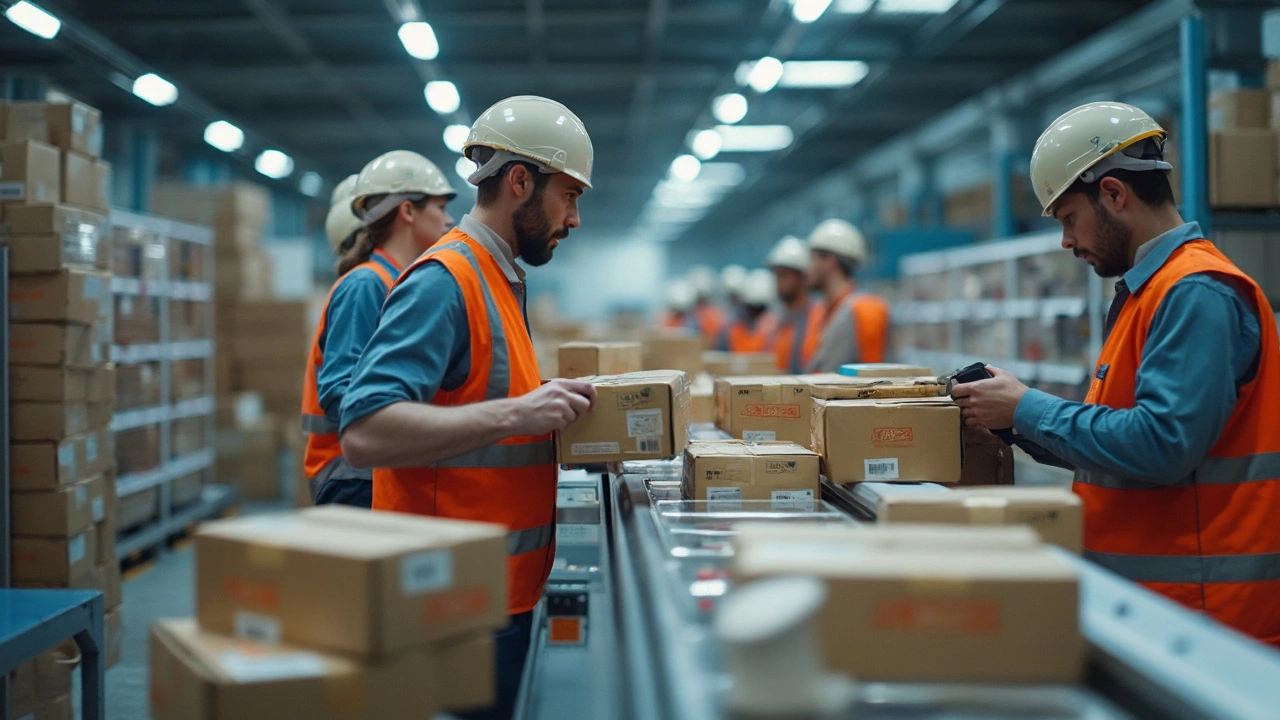E-commerce sounds like just selling stuff online, but there’s way more going on than most folks think. It’s all about making it as easy as possible for someone to click buy, pay safely, and actually get their item without any hassle. If you’re new to the game, you might picture big warehouses, fancy websites, or deliveries flying across the map. But even a single person selling stuff from their living room is technically running an e-commerce business.
The real action starts behind the scenes with logistics. As soon as someone clicks “order,” a whole chain of events kicks off—packing the order, deciding which shipping service will get it there fastest, even handling returns if things don’t work out. Mess this up, and you could lose the sale or your reputation. Get it right, and even a tiny store can keep customers coming back.
If you’re thinking about jumping in, just know you don’t need a huge budget or a tech team. Plenty of tools and smart strategies can help you get started without losing your mind or your money. The rest of this guide lays out what’s involved, some handy tools, and common mistakes you want to dodge right from day one.
- What is E-commerce, Really?
- First Steps: Setting Up Your Online Store
- How Logistics Shape Success
- Popular Tools and Helpful Tips
- Biggest Mistakes Beginners Make
What is E-commerce, Really?
When folks ask what e-commerce is, most just think it’s about buying or selling stuff on the internet. That hits the broad strokes, but there’s a bit more to it. E-commerce covers every money-making move you do online—selling sneakers direct from your garage, running a massive clothing site, even sending digital products like ebooks or software. If cash leaves a customer’s account and ends up with a business, and it starts online, you’re talking about e-commerce.
Every time you shop on Amazon or a local store’s website, you’re diving into the e-commerce world. The cool part? Some shops never touch a product—they simply get orders and hand them off to a partner who ships straight to your doorstep. This is called dropshipping, and it’s getting more common, especially for folks just starting out who don’t want piles of inventory in their home.
Before we jump ahead, check out how big this thing really is:
| Year | Global E-commerce Sales (USD) |
|---|---|
| 2021 | $4.9 trillion |
| 2022 | $5.7 trillion |
| 2024 (estimated) | $6.9 trillion |
That’s not just big business—that’s a lot of shoes, gadgets, and groceries flying out in brown boxes. And those numbers aren’t only from massive brands. Many small stores, side hustles, and even single-product businesses share in that pile.
There are a few types of e-commerce you might want to know about:
- B2C (Business to Consumer): Like ordering headphones from Best Buy.
- B2B (Business to Business): Think office supply companies selling to other businesses.
- C2C (Consumer to Consumer): That’s eBay or Facebook Marketplace, where individuals sell to each other.
- D2C (Direct to Consumer): Brands selling right from their own website, skipping the big chains.
One thing ties it all together: logistics. Even the smoothest-looking store is really just one part of a chain that connects a e-commerce shopper to what they ordered, fast and hassle-free. Without good logistics, stores struggle to keep promises and customers bail fast. So it’s not just about selling—the action behind the scenes matters just as much.
First Steps: Setting Up Your Online Store
Getting your online shop up and running isn’t rocket science, but there’s more to it than just picking a name and slapping products onto a website. You’ve got to nail down a few must-dos so you don’t waste time or money off the bat.
To start, figure out what you actually want to sell. Look for products that you either know a lot about, already own, or can get quickly. Here’s a quick peek at some of the top e-commerce product categories by global sales in 2024:
| Category | Share of Sales (%) |
|---|---|
| Fashion | 21% |
| Electronics | 18% |
| Home & Kitchen | 14% |
| Health & Beauty | 12% |
Next, pick the kind of shop setup that fits you best. Some folks use all-in-one platforms, while others build from scratch. For beginners, the top hosts in 2025 are Shopify, Wix, and BigCommerce—these are easy to use and don’t need coding skills. If you already like selling stuff on Instagram or Facebook, both make adding a storefront pretty simple now.
You don’t want to skip payment setup. Most buyers expect to see big names like PayPal, Apple Pay, or Stripe when they checkout. One survey found that 27% of shoppers leave a website if their favorite payment option isn’t there. So, give people choices!
- Sign up for your platform (Shopify, Wix, etc.).
- Add your products—use real photos, simple details, and honest descriptions.
- Set up shipping rules so buyers can see what shipping costs and timelines look like right away.
- Connect payment methods, making sure local customers aren’t left out.
- Test your purchase process—buy something from yourself before you ever go live.
Your e-commerce shop should be fast and work just as well on a phone as on a laptop. In 2024, over 60% of e-commerce sales happened on mobile devices, so double-check that your store looks good and loads fast on your phone.
These basics might sound simple but skipping any step can tank your first few sales. Get your foundation right, and you’ll spend way less time fixing problems later.

How Logistics Shape Success
If you want an online business to survive, logistics can’t be an afterthought. It’s the engine that gets the whole e-commerce machine moving. When someone clicks the checkout button, what happens next decides if they’ll become a repeat customer or vow never to shop with you again.
Think about what needs to go right: You need inventory in stock, orders packed fast, parcels labeled correctly, and shipping that won’t break the bank. Even Amazon’s two-day delivery wouldn’t exist without slick logistics. According to a 2024 survey by MetaPack, 69% of shoppers say they won’t order again from an online store if their package arrives late or damaged.
A smooth logistics side means:
- Quick and accurate order processing
- Packing and labeling with zero mistakes
- Affordable and reliable shipping options
- Easy tracking for the customer
- Fast returns or exchanges
Here’s a peek at some eye-opening e-commerce logistics data that highlight just how much getting these basics wrong can cost:
| Logistics Factor | What Can Go Wrong | Typical Impact |
|---|---|---|
| Late Shipments | Delayed packages | 22% drop in repeat orders |
| Incorrect Address Labeling | Misdelivered items | $17 average loss per order |
| Poor Packaging | Damaged products | Over half result in returns |
| No Order Tracking | Customers contact support | Extra cost and bad reviews |
The biggest e-commerce players all tackled logistics first, because they knew people care more about getting their e-commerce order on time than having a fancy website. Some smaller shops even use third-party fulfillment centers, so they don’t have to deal with storage and shipping headaches. Popular choices in 2025 include ShipBob, Amazon FBA, and Shopify Fulfillment Network—they let you scale up without needing your own warehouse.
One last thing: don’t try to do everything manually. Start small if you need to, but set up your process so it can keep up when sales take off. Automation tools for tracking, sending shipping notifications, and managing stock save time (and save your nerves).
Popular Tools and Helpful Tips
If you want to run an online store and not lose your mind over the details, the right tools make all the difference. There are actually a handful of platforms, shipping partners, and add-ons that most stores big and small rely on every day. Here’s what works, especially if you’re just starting out in e-commerce.
- Shopify: Probably the easiest all-in-one platform for beginners. You get templates, payment tools, inventory control, and shipping partnerships built in. It's clean and doesn’t take a tech genius to get started.
- WooCommerce: If you already have a WordPress site, this plug-in is free, flexible, and lets you tack on an online shop. It handles products, payments, and customer orders without a separate website.
- ShipStation: Shipping is make-or-break. This integrates with major carriers like UPS, FedEx, and USPS, cuts out label headaches, and automates a bunch of annoying tasks like tracking numbers.
- Google Analytics: Don’t fly blind. This free tool shows you which products are hot, where shoppers come from, and where they drop off. You can tweak your site based on real data, not guesses.
- Klaviyo: Email still works. This platform helps you send the right deals to the right customers at the right time—think abandoned cart reminders and product launches that bring folks back.
If you want to avoid the common mess-ups in logistics, pay attention to details like order cutoff times—the earlier you catch an order, the faster you can ship it out. Try not to promise what you can't deliver. Slow shipping or messed up tracking costs you trust. Here’s some quick data on what actually matters to shoppers:
| Factor | Why It Matters |
|---|---|
| Shipping Speed | 62% of online buyers expect orders in less than 3 days |
| Tracking Updates | 83% want real-time tracking as soon as they order |
| Easy Returns | 54% check for a clear return policy before buying |
Quick tip: Use automated shipping emails and tracking updates. Most e-commerce platforms set this up for you. Shoppers feel in the loop, you get fewer “Where’s my order?” emails.
One last thing—keep your product descriptions honest and your photos accurate. Overpromising means more returns, which means higher costs and more work for you. If you can, start with 5–10 products until you get the hang of stock management and shipping. Once that’s running smooth, then scale up.

Biggest Mistakes Beginners Make
Jumping into e-commerce is exciting, but it comes with a learning curve. A lot of beginners run into the same pitfalls—the good news is that most of them are easy to avoid once you know what to watch for. Here’s the low-down on the top screw-ups new sellers make and how to sidestep them.
- Choosing the Wrong Shipping Methods: It’s tempting to pick the cheapest carrier or ignore delivery speed. Yet, 38% of online shoppers say they’ll ditch their cart if shipping takes too long or costs too much. Fast and transparent shipping options aren’t optional anymore—they’re expected.
- Ignoring Inventory Management: Running out of products or selling stuff that’s actually out of stock makes customers angry and costs you sales. Many beginners underestimate how quickly items can move—or don’t have a system to track what’s left.
- Overcomplicating Returns: Too many rules or a confusing returns process drives buyers away. Clear and simple return policies keep customers happy, even when something goes wrong.
- Forgetting About Customer Support: Even a tiny shop needs a way for people to ask questions or report problems. Slow replies or ignored emails will wreck your reputation fast in the e-commerce world.
- Not Tracking Key Numbers: If you aren’t checking your sales, delivery times, or return rates, you’re flying blind. Analytics tools are easy to set up, and you don’t need to be a math whiz to spot when something’s off.
Here’s a quick look at how beginner mistakes can add up over time:
| Mistake | Impact | Stat/Example |
|---|---|---|
| Slow Shipping | Cart abandonment, lost sales | 38% leave carts for slow/expensive shipping (Baymard Institute, 2024) |
| Poor Inventory Tracking | Out-of-stock refunds, unhappy customers | 30% of negative reviews mention "item unavailable" (Trustpilot, 2023) |
| No Returns Policy | Fewer purchases, high complaint rates | 67% check returns info before buying (Narvar Shopper Report, 2024) |
| Lack of Support | Bad reviews, fewer repeat customers | Customers expect a reply within 24 hours (Statista, 2023) |
One smart move: set up alerts for low stock and regularly check how long orders take to reach customers. Compare your numbers to industry averages and tweak your process as you go. If you catch these rookie mistakes early, you’re ahead of most new e-commerce sellers.


